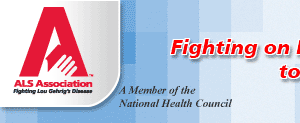

 |
 |
|
May 1, 2008 New Research on ALS Presented at AAN Annual Meeting A wealth of new research on the causes, risk factors, and potential treatments of ALS was presented at the 60th Annual Meeting of the American Academy of Neurology. Held this year in Chicago, this is the premier meeting of neurologists from around the world, who come to share results of some of the most important new research in neurology. Genes and Other Causative Factors Variants in the chromagranin gene may increase the risk for ALS, according to Dr. Jean-Pierre Julien of Quebec and colleagues. Recently, the chromagranin protein was found to interact with the SOD1 protein (mutations in SOD1 are linked to 2% of ALS). Dr. Julien showed that patients with non-SOD1 familial ALS, as well as patients with no family history of ALS, were more likely to have certain gene variants in chromagranin than people without ALS. Meanwhile, Swedish and Irish researchers, led by Dr. Orla Hardiman, showed that variants in another gene, angiogenin, are associated with sporadic (non-familial) ALS. These gene variants have previously been linked to familial ALS. Both findings will need to be examined in more detail to gauge their significance. However, by determining how these genes act, it may be possible to understand better how ALS develops. Dr. Kay Davies and colleagues at Oxford University showed that, in a mouse model of ALS, reducing the level of another protein, called SMN, worsened the disease. Loss of SMN is known to be the cause of spinal muscular atrophy, which, like ALS, affects motor neurons. These results indicate that SMN is important for motor neurons and may contribute to the disease in ALS, suggesting that treatments to increase SMN may be beneficial. One such treatment, valproate, is discussed in the “Clinical Trials” below. Dr. Guy Rouleau and colleagues in Montreal have discovered the location of a gene that causes primary lateral sclerosis, a condition similar to ALS. While further research will be needed to identify the gene at this location, this may lead to a better understanding of how motor neurons die in the two diseases. Along with genes, researchers presented data on several other possible contributors to the ALS disease process. Dr. Grace Zhai and colleagues from Miami showed that, in flies, small amounts of a toxin called BMAA (beta-N-methylamino-L-arginine) can cause neuron loss. BMAA is an excitatory amino acid, produced and released by certain types of bacteria. Since this toxin is widely distributed in the environment, it may be one potential environmental contributor to ALS. Dr. Michael Strong and colleagues from Toronto found that a protein called TDP-43, previously implicated in some cases of ALS, interacts with mutant SOD1, the cause of many cases of familial ALS. As a pair, they appear to influence how the genetic instructions for other proteins are handled. This finding suggests that improper interaction of the two may contribute to ALS. Inflammation arises when the immune system reacts to danger. Outside of the brain, inflammation can help the body fight off infection, but inside, inflammation may cause more problems than it solves. A molecule called interleukin 4 dampens down inflammation in the brain, but Dr. Guillermo Alexander and colleagues from Philadelphia presented evidence that, in ALS patients, there are more antibodies that neutralize interleukin 4, which may allow more inflammation, which could worsen ALS. Risk Factors and Influences on Progression The influence of several factors on progression of disease was assessed by a variety of groups. A recent report raised the possibility that use of statins (blood pressure-controlling medications) might increase the risk of ALS. Dr. Beatrice Nefussy and colleagues from Tel Aviv did not address that question, but did show that for those already diagnosed with ALS, using statins was safe and did not hasten disease progression. Dr. Richard Bedlack and colleagues of Duke University found that for veterans of the military with ALS, a deployment to Vietnam was associated with a faster decline. They did not identify any specific exposures that might account for this association. Dr. Merit Cudkowicz and colleagues of Massachusetts General Hospital showed that the average rate of disease progression in ALS has not changed over the past decade. This is in contrast to improvements in prior decades, which are believed to have been due to improvements in care of ALS patients over that time. Dr. Alberto Ascherio and colleagues of Harvard Medical School found that cigarette smoking slightly increases the risk of ALS. The reasons for this link are not yet known. Clinical Issues in ALS: Cognition, Pain, Respiration Several groups looked at the important issue of how ALS affects cognitive (thinking) abilities. Cognition is made up of many different individual skills, from word recognition to memory to planning. Dr. Orla Hardiman and colleagues from Dublin showed that about a third of ALS patients they studied had impaired memory, about the same proportion were slower at recalling items they were trying to name, and the majority had reduced verbal fluency. By combining data from many studies, Dr. Marianne De Visser from The Netherlands showed that cognitive impairment was even more widespread and was tied to disease duration. Dr. Marina De Tommaso and colleagues from Italy confirmed and extended recent data showing pain occurs in a high proportion of ALS patients. Pain was reported by 86% of patients, most frequently cramp and musculoskeletal pain in the legs or arms. Over-the-counter pain relievers helped some, but not all, patients. Diaphragm Pacing Stimulation (DPS) is a new technique for helping weakened respiratory muscles to continue working as ALS progresses. Dr. Raymond Onders and colleagues from Case Western Reserve University studied a group of patients using DPS and presented results showing that it is possible to carefully monitor the effect of the technique, and the action of the diaphragm (the main breathing muscle), meaning it may be possible to use this monitoring system to more accurately follow patients and their response to treatment. Clinical Trials High-dose coenzyme Q-10 did not improve outcomes compared to placebo, according to a study presented by Dr. Petra Kaufmann of Columbia University. CoQ10 is designed to aid mitochondria, the cell’s powerhouses, which are thought to be impaired in ALS. This study was designed to test whether a larger trial of CoQ10 should be undertaken, and these results suggest it would not be productive to do so. No benefit was seen from treatment with valproic acid, according to Dr. Leonard van den Bergh and colleagues of the Netherlands. This drug has been investigated in spinal muscular atrophy for its ability to increase the SMN protein (see above). Since SMN is also thought to be important in protecting motor neurons in ALS, it was hoped that treatment with valproic acid would be beneficial, but these results indicate this did not occur. A small trial of pyrimethamine showed that it can lower the level of SOD1, the protein that, when mutated, causes many cases of familial ALS. The two patients in this trial had SOD1-related ALS, and received the drug for 18 weeks. According to results from Dr. Daniel Benjamin and colleagues from New Jersey, the treatment lowered the amount of SOD1 in their nervous systems, but caused significant headache, nausea, and malaise. Further studies will be needed to determine if the drug can be made more tolerable, and if the effect on SOD1 translates into clinical benefit. Two studies investigated aspects of stem cell treatment Transplantation of stem cells has been widely discussed in ALS, and one controversial and unproven procedure, called olfactory ensheathing cell transplantation, is available outside the U.S. Dr. Adriano Chio and colleagues from Turin examined at autopsy one of their patients who had undergone such a procedure (and obtained no benefit from it). They found there was no evidence any of the implanted cells had begun to integrate into the patient’s own nervous system, or showed signs of having become functional motor neurons. GCSF (granulocyte colony stimulating factor) stimulates one type of the body’s own stem cells and has been shown to improve survival in the mouse model of ALS. Dr. Corrado Tarella and colleagues from Turin showed that GCSF caused few side effects, and treatment increased the number of its target stem cells in the bloodstream. Further study will be needed to see if this can benefit patients. |
|
| |||
The ALS Association �2004 The ALS Association. All rights reserved. Contact the Webmaster |